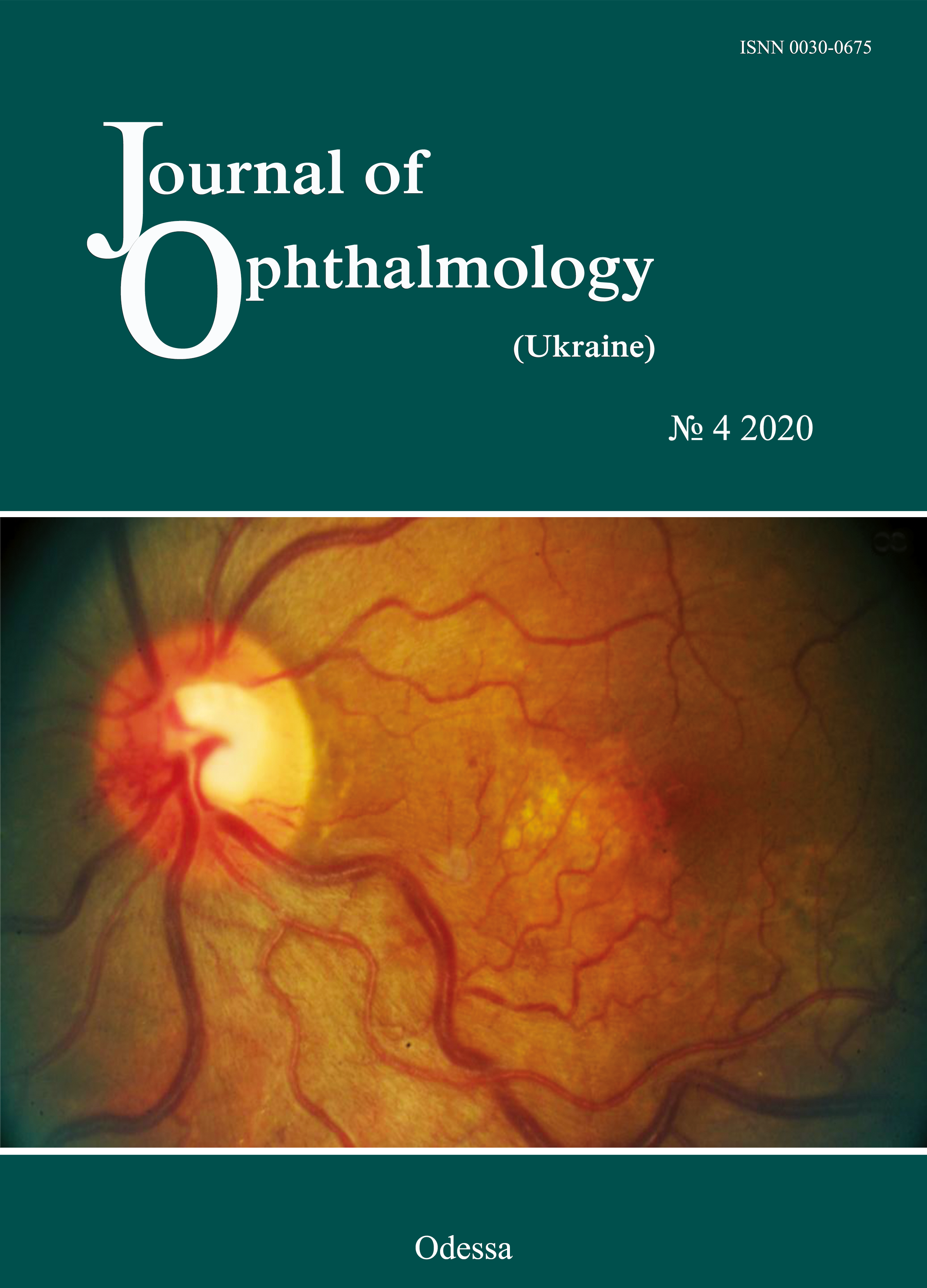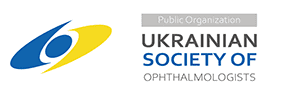Brain potential response to activation procedures in children with refractive amblyopia
DOI:
https://doi.org/10.31288/oftalmolzh202043337Keywords:
refractive amblyopia, brain potential, electroencephalography, EEGAbstract
Purpose: To identify the features of cortical potential response to activation procedures in patients with mild and moderate refractive amblyopia.
Material and Methods: We examined electroencephalography (EEG) response to activation procedures (specifically, eye opening and photic stimulation) in 22 pediatric amblyopes and 15 healthy children. All subjects underwent an eye examination, including visual acuity measurement, ophthalmoscopy, and refractometry. In addition, binocular function was assessed using the Worth 4-dot test and synoptophore. An EEG response to alternating unilateral eye opening was used as an indicator of the integrity of the prechiasmal pathway. A response to 10-Hz rhythmic photic stimulation (rhythmic driving response, RDR) was used as a measure of maturity of cortical neurons. The performance of the thalamocortical relay was assessed through the RDR to unilateral and bilateral photic stimulation with the eyes closed to exclude the effect of reticular formation. In addition, eyes closed EEG synchronization was assessed at symmetric EEG derivations to detect the absence of connection through the corpus callosum.
Results: In the total sample of children with mild and moderate refractive amblyopia, there was an increased rate of a weak desynchronization response to bilateral eye opening and to unilateral eye opening in the hemisphere ipsilateral to the amblyopic eye. Particularly, a weak response was exhibited by all patients without binocular vision. In addition, we found the absence of slow waves in both hemispheres during rhythmic driving response to binocular photic stimulation and during response to bilateral eye opening.
Conclusion: Findings of this study (1) evidence immaturity of cortical and midbrain neurons and (2) confirm the integrity of the major retinal cortical pathway and retinal thalamic cortical pathway and their interhemispheric connection in children with mild and moderate refractive amblyopia.
References
1.Demer JL, von Noorden GK, Volkow ND. Imaging of cerebral blood flow and metabolism in amblyopia by positron emission tomography. Am J Ophthalmol. Am J Ophthalmol. 1988 Apr 15;105(4):337-47.https://doi.org/10.1016/0002-9394(88)90294-2
2.Hubel DH, Wiesel TN. Cells sensitive to binocular depth in area 18 of the macaque monkey cortex. Nature. 1970 Jan 3;225(5227):41-2.https://doi.org/10.1038/225041a0
3.Crawford MLJ, von Noorden GK, Meharg LS, et al. Binocular neurons and binocular function in monkeys and children. Invest Ophthalmol Vis Sci. 1983. 1983 Apr;24(4):491-5.
4.Hubel DH, Wiesel TN. Receptive fields and functional architecture of monkey striate cortex. J Physiol. 1968 Mar;195(1):215-43.https://doi.org/10.1113/jphysiol.1968.sp008455
5.Hubel DH, Wiesel TN, LeVay S. Plasticity of ocular dominance columns in monkey striate cortex. Philos Trans R Soc Lond B Biol Sci. 1977 Apr 26;278(961):377-409.https://doi.org/10.1098/rstb.1977.0050
6.Ikeda H. Is amblyopia a peripheral defect? Trans Ophthalmol Soc UK. 1979;99(3):347-52.
7.Ikeda H. Visual acuity, its development and amblyopia. J R Soc Med. 1980 Aug;73(8):546-55.https://doi.org/10.1177/014107688007300803
8.Ibatulin RA. [Visual functions in amblyopia as assessed by psychophysical and electrophysiological studies]. Thesis of dissertation for the degree of Dr Sc (Med). Moscow: Helmholtz Research Institute of Eye Diseases; 1998. Russian.
9.Norcia AM, Tyier C. Spatial frequency sweep VEP: visual acuity during the first year of life. Vision Res. 1985;25(10):1399-408.https://doi.org/10.1016/0042-6989(85)90217-2
10.Orel-Bixler DA. Subjective and VEP measures of acuity in normal and amblyopic adults and children. University of California, Berkeley, 1989.
11.Simmers AJ, Ledgeway T, Hess RF, McGraw PV. Deficits to global motion processing in human amblyopia. Vision Res. 01 Mar 2003, 43(6):729-738.DOI: https://doi.org/10.1016/S0042-6989(02)00684-3
13.Peper E, Mulholland T. Methodological and theoretical problems in the voluntary control of EEG occipital alpha by the subject. Kybernetik. 1970. 7:10-3.https://doi.org/10.1007/BF00270329
14.Shibinskaia NI. [Study of bioelectric activity of the cerebral cortex in dysbinocular amblyopia according to electroencephalographic data]. Oftalmol Zh. 1975;30(6):467-70.
15.Shamshinova AM, Iakovlev AA, Romanova EV. [Clinical physiology of vision]. Moscow: MBN; 2002. Russian.
16.Dobromyslov AN. [On the conditional reflex-associated nature of binocular vision and concomitant strabismus]. Vestn Oftalmol. 1963;3:160-5. Russian.
17.Avetisov SE. [Strabismic amblyopia and its management]. Moscow: Meditsina; 1968. p.5-38, 207. Russian.
18.Zislina NN, Sorokina RS. [The effect of functional and organic disorders in the visual system on the amplitude-temporal characteristics of evoked potentials]. Fiziol Cheloveka. 1991 May-Jun;17(3):27-33.
19.Zislina NN, Shamshinova AM. [Physiological basics and potential for application of visual evoked potentials in differential diagnosis of eye disease]. In: [Clinical physiology of vision]. Moscow: Rusomed; 1993. p. 146-57. Russian.
20.Dubovskaia LA. [Pathogenesis targeted therapeutic approaches in children with amblyopia and partial optic nerve atrophy]. Thesis of dissertation for the degree of Dr Sc (Med). Moscow: Helmholtz Research Institute of Eye Diseases; 1977. Russian.
21.Zinchenko VP, Vdovina LI, Gordon VM. [Study on the functional structure of combinatory problem solving]. In: [Motor components of vision]. Moscow: Nauka; 1975. Russian.
22.Hou C, Good WV, Norcia AM. Norcia. Detection of Amblyopia Using Sweep VEP Vernier and Grating Acuity. Invest Ophthalmol Vis Sci. 2018 Mar 1;59(3):1435-1442.https://doi.org/10.1167/iovs.17-23021
23.Zenkov LR. [Electroencephalography (with Elements of Epileptology)]. Taganrog: TGRU; 1996. Russian.
24.Gnezditskii VV, Shamshinova AM. [Clinical experience of the use of evoked potentials]. Moscow: MBN; 2001. Russian.
25.Zhirmunskaia EA, Maiorchik VE, Ivanitskii AM. [Terminology manual (glossary of EEG terms)]. Vol. 4. Moscow: Meditsina; 1978. p. 936-54. Russian.
Downloads
Published
How to Cite
Issue
Section
License
Copyright (c) 2025 И. М. Бойчук, Бадри Ваел

This work is licensed under a Creative Commons Attribution 4.0 International License.
This work is licensed under a Creative Commons Attribution 4.0 International (CC BY 4.0) that allows users to read, download, copy, distribute, print, search, or link to the full texts of the articles, or use them for any other lawful purpose, without asking prior permission from the publisher or the author as long as they cite the source.
COPYRIGHT NOTICE
Authors who publish in this journal agree to the following terms:
- Authors hold copyright immediately after publication of their works and retain publishing rights without any restrictions.
- The copyright commencement date complies the publication date of the issue, where the article is included in.
DEPOSIT POLICY
- Authors are permitted and encouraged to post their work online (e.g., in institutional repositories or on their website) during the editorial process, as it can lead to productive exchanges, as well as earlier and greater citation of published work.
- Authors are able to enter into separate, additional contractual arrangements for the non-exclusive distribution of the journal's published version of the work with an acknowledgement of its initial publication in this journal.
- Post-print (post-refereeing manuscript version) and publisher's PDF-version self-archiving is allowed.
- Archiving the pre-print (pre-refereeing manuscript version) not allowed.












